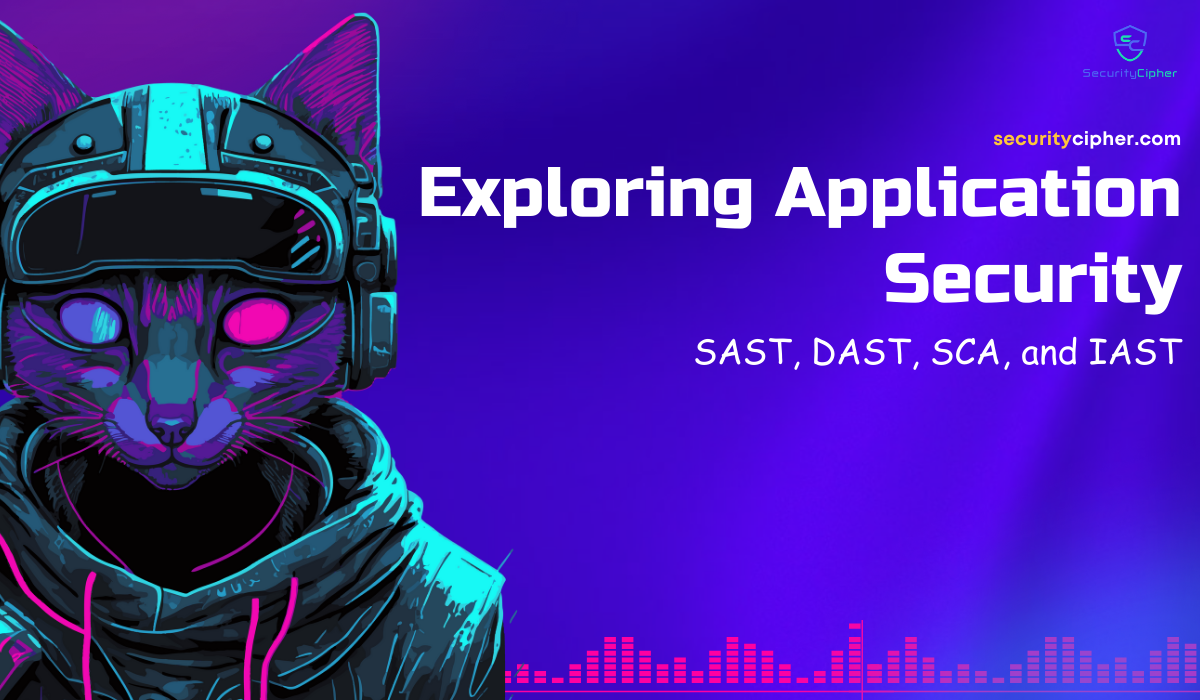Welcome to today’s blog, where we’ll explore the world of software security testing. In an era where cyber threats are on the rise, it’s crucial to understand different testing approaches that help safeguard our digital creations. We’ll break down four essential methods: Static Code Analysis (SAST), Dynamic Application Security Testing (DAST), Software Composition Analysis (SCA), and Interactive Application Security Testing (IAST). We’ll learn what each of these does, how they work, and where they shine. By the end, you’ll have a clear picture of the tools available to fortify your applications against potential security risks. Let’s dive in and demystify the complexities of SAST, DAST, SCA, and IAST, making your journey toward a more secure digital environment both insightful and practical.
Introduction
In the dynamic landscape of software development, security has become a paramount concern. As the digital realm expands and technology intertwines with every aspect of our lives, the vulnerabilities within software applications pose significant threats. The increasing sophistication of cyber threats necessitates a robust and multi-faceted approach to security. This is where different testing approaches come into play, providing essential layers of defense to safeguard against potential exploits and breaches.
The Need for Testing Approaches
Testing is a critical component of any robust security strategy. It serves as a proactive means to identify and rectify vulnerabilities before they can be exploited. However, not all vulnerabilities can be effectively addressed with a one-size-fits-all testing approach. Different types of vulnerabilities require distinct methods of detection, and this is where specialized testing approaches come into play.
Diverse Testing Approaches: A Necessity
To comprehensively secure software applications, organizations employ a variety of testing approaches, each designed to address specific aspects of security. This diversity ensures a more thorough examination of the application’s security posture, covering both code-level vulnerabilities and runtime exploits. The four primary testing approaches—Static Code Analysis (SAST), Dynamic Application Security Testing (DAST), Interactive Application Security Testing (IAST), and Software Composition Analysis (SCA)—offer distinct perspectives on potential vulnerabilities, collectively forming a robust defense against a broad spectrum of security threats.
Static Code Analysis (SAST)
Static Code Analysis, commonly referred to as SAST, is a method of software testing that examines the source code of an application or program without executing it. The analysis is performed during the development phase, allowing developers to identify potential security vulnerabilities, coding errors, and compliance issues before the software is deployed.
How SAST Works
- Source Code Examination: SAST analyzes the source code or binary code of an application without the need for runtime execution.
- Pattern Matching: It employs pattern-matching techniques to identify known security vulnerabilities and coding patterns.
- Data Flow Analysis: SAST traces the flow of data within the code, identifying potential security weaknesses and vulnerabilities.
- Rule-Based Analysis: SAST uses predefined rules and coding standards to flag potential issues.
Pros and Cons of SAST
Pros:
- Early Detection: Identifies vulnerabilities during the development phase, allowing for early resolution.
- Comprehensive Coverage: Examines the entire codebase for potential issues.
- Integration into SDLC: Easily integrated into the software development lifecycle (SDLC) for continuous monitoring.
Cons:
- False Positives: SAST tools may produce false positives, requiring manual verification to differentiate between actual vulnerabilities and benign code.
- Limited Runtime Context: Unable to identify issues that only manifest during runtime.
- Resource Intensive: SAST can be time-consuming and resource-intensive, potentially slowing down the development process.
Use Cases and Scenarios Where SAST is Most Effective
- Early Development Stages: SAST is particularly effective during the early stages of development when identifying and fixing vulnerabilities is less costly.
- Large Codebases: Ideal for projects with extensive codebases where manual code review might be impractical.
- Code Audits and Compliance: Useful for ensuring adherence to coding standards, best practices, and compliance requirements.
- Continuous Integration/Continuous Deployment (CI/CD): Fits seamlessly into CI/CD pipelines, providing continuous security feedback throughout the development lifecycle.
- Security Training and Education: SAST can serve as an educational tool for developers, helping them understand and address security issues in their code.
In conclusion, Static Code Analysis plays a crucial role in the proactive identification and mitigation of security vulnerabilities, offering a valuable layer of defense in the software development process. While it has its limitations, when used appropriately, SAST significantly contributes to building secure and resilient applications.
Dynamic Application Security Testing (DAST)
Dynamic Application Security Testing (DAST) is a security testing methodology designed to identify vulnerabilities and weaknesses in a running web application or software system. Unlike static analysis, which examines the source code without execution, DAST assesses applications in their runtime environment. This approach mimics real-world attack scenarios, providing insights into how the application responds to various inputs and interactions.
How DAST Works
DAST operates by actively probing an application in its running state. The testing tool simulates real-world attacks by sending various requests and inputs to the application, and analyzing its responses for vulnerabilities. This includes testing for common web application security issues such as SQL injection, cross-site scripting (XSS), and security misconfigurations. DAST tools typically interact with the application through its external interfaces, like web pages and APIs.
Pros and Cons of DAST
Pros:
- Real-world Simulation: DAST provides a realistic simulation of how an application behaves under actual attack conditions.
- No Access to Source Code: DAST does not require access to the application’s source code, making it suitable for third-party assessments or black-box testing.
- Comprehensive Coverage: It can cover a wide range of vulnerabilities that might be missed by static analysis alone.
Cons:
- Limited Code Visibility: Since DAST doesn’t analyze the source code, it may miss certain vulnerabilities that are only detectable through static analysis.
- False Positives: DAST tools might generate false positives, as they rely on observed behavior rather than a deep understanding of the application’s internal logic.
- Late Discovery: Identifying and fixing vulnerabilities late in the development process can be more time-consuming and expensive.
Use Cases and Scenarios Where DAST is Most Effective
- Web Application Security Assessments: DAST is particularly effective for assessing the security of web applications, as it can simulate attacks on the application’s interfaces and identify vulnerabilities in the runtime environment.
- Black-Box Testing: DAST is well-suited for black-box testing scenarios where the tester has limited knowledge of the internal workings of the application.
- Regular Security Audits: Periodic DAST scans can be integrated into a security audit strategy, helping organizations identify and remediate vulnerabilities in their applications on an ongoing basis.
- Third-Party Vendor Assessments: When assessing the security of applications developed by third-party vendors, DAST can be valuable due to its independence from the application’s source code.
- Dynamic Environments: In agile development environments or scenarios where applications frequently change, DAST can adapt to these dynamic conditions and provide continuous security assessments.
Understanding the strengths and limitations of DAST is crucial for incorporating it effectively into an overall application security testing strategy. While it excels in certain scenarios, combining DAST with other testing methodologies can provide a more comprehensive and robust security posture for an organization.
Software Composition Analysis (SCA)
Software Composition Analysis (SCA) is a security testing methodology that focuses on identifying and managing open-source and third-party components in software applications. It involves analyzing and monitoring the dependencies within the application’s codebase to identify vulnerabilities in the libraries and frameworks used.
SCA is crucial because many software applications rely on third-party components for efficiency and functionality. However, these components may introduce security vulnerabilities that can be exploited by attackers. SCA tools help developers and security teams identify and address such vulnerabilities early in the development lifecycle.
How SCA Works
- Component Identification: SCA tools scan the application’s codebase to identify all the third-party components and libraries used.
- Vulnerability Detection: The tools cross-reference the identified components with known vulnerability databases to check for any security issues or updates.
- License Compliance: SCA also ensures compliance with licensing agreements by identifying and reporting on licenses associated with each component.
- Continuous Monitoring: SCA is often integrated into the development pipeline, providing continuous monitoring to catch new vulnerabilities as they are discovered.
Pros and Cons of SCA
Pros:
- Early Detection: Identifies vulnerabilities early in the development process, reducing the risk of security breaches.
- Comprehensive Coverage: Offers a comprehensive view of all third-party components and associated vulnerabilities.
- License Compliance: Helps maintain compliance with open-source licenses.
Cons:
- False Positives: Like any automated tool, SCA may generate false positives, requiring manual verification.
- Limited to Dependencies: Primarily focuses on third-party components, potentially overlooking vulnerabilities in the application’s custom code.
Use Cases and Scenarios Where SCA is Most Effective
- Large Codebases with Many Dependencies: SCA is particularly effective in applications with extensive codebases and numerous dependencies, where manual tracking would be impractical.
- DevOps and CI/CD Environments: SCA integrates well into DevOps and CI/CD pipelines, ensuring that security checks are an integral part of the development process.
- Regulated Industries: Industries with strict compliance requirements, such as finance or healthcare, benefit from SCA’s ability to ensure license compliance and security standards.
- Projects with Rapid Development Cycles: SCA is well-suited for projects with frequent updates and releases, where continuous monitoring is essential for maintaining security.
By understanding the definition, functionality, pros, and cons of Software Composition Analysis, developers and security professionals can make informed decisions about integrating SCA into their development processes to enhance the overall security posture of their applications.
Interactive Application Security Testing (IAST)
Interactive Application Security Testing (IAST) is a dynamic security testing method designed to identify vulnerabilities in applications while they are running. Unlike traditional methods, IAST analyzes an application from the inside during runtime, providing real-time feedback on potential security issues.
IAST combines aspects of both static and dynamic testing methodologies, leveraging its unique position within the application runtime environment to detect vulnerabilities and weaknesses that might be challenging to identify through other testing approaches.
How IAST Works
- Instrumentation: IAST instruments the application during runtime, injecting sensors or agents into the application’s codebase. These agents actively monitor the application’s behavior and interactions with external components.
- Real-Time Analysis: As the application runs, IAST continuously analyzes the code, data flow, and runtime dependencies. It captures relevant security information and assesses the impact of various inputs on the application’s security posture.
- Dynamic Contextual Awareness: IAST adapts to the dynamic context of the application, recognizing the specific paths and scenarios that might trigger security vulnerabilities. This contextual awareness enhances the accuracy of vulnerability detection.
Pros and Cons of IAST
Pros:
- Accuracy: IAST tends to provide more accurate results compared to traditional testing methods, as it analyzes the application in its actual runtime environment.
- Reduced False Positives: The real-time nature of IAST helps in reducing false positives, focusing on actual vulnerabilities that are exploitable.
- Integration with SDLC: IAST can be integrated into the software development lifecycle (SDLC), allowing for continuous monitoring and testing during development.
Cons:
- Limited Coverage: IAST may not cover all aspects of an application, especially if certain parts of the code are not exercised during testing.
- Dependency on Application State: Results may vary based on the specific state of the application during testing, potentially missing vulnerabilities that only manifest under specific conditions.
Use Cases and Scenarios Where IAST is Most Effective
- DevOps and Continuous Integration: IAST is well-suited for DevOps environments where continuous testing and integration are crucial. Its ability to seamlessly integrate into the development pipeline makes it effective in these scenarios.
- Complex Web Applications: IAST excels in assessing complex web applications with intricate interactions and dependencies, where traditional testing approaches may fall short.
- Identification of Runtime Vulnerabilities: IAST is particularly effective in identifying runtime vulnerabilities such as injection attacks, security misconfigurations, and authentication issues that may not be evident in static analysis.
- Applications with Frequent Code Changes: In environments where code changes frequently, IAST provides real-time security feedback without the need for exhaustive test scenarios.
Understanding the strengths and limitations of IAST is essential for organizations seeking a balanced and effective approach to application security testing. Its integration into a broader security testing strategy can enhance overall risk mitigation in the software development lifecycle.
Comparative Analysis
Below is a table comparing Software Composition Analysis (SCA), Static Application Security Testing (SAST), Dynamic Application Security Testing (DAST), and Interactive Application Security Testing (IAST):
| Criteria | SAST | DAST | SCA | IAST |
|---|---|---|---|---|
| Focus | Source code | Running applications | Dependencies and third-party components | Real-time application monitoring |
| Timing | Before runtime | During runtime | Before runtime | During runtime |
| Access to Source Code | Required | Not required | Not required | Required (partial) |
| Detection Method | Static Code Analysis | Dynamic Analysis | Vulnerability Database | Hybrid of Static and Dynamic Analysis |
| Scope of Testing | Entire source code | External interfaces and runtime behavior | Libraries and frameworks | Runtime behavior and source code (partial) |
| False Positives | Moderate | Moderate to High | Low | Moderate |
| Applicability | Entire codebase | Web applications | Third-party components, Open source | Web applications, Limited language support |
| Use Cases | Security code review, Compliance checks | Regular security audits, Black-box testing | License compliance, Dependency analysis | Continuous security monitoring, DevSecOps |
| Advantages | Comprehensive code analysis | Realistic simulation of attacks | Early detection of vulnerabilities | Real-time monitoring, Fewer false positives |
| Disadvantages | Limited to the analyzed codebase | Late discovery of vulnerabilities | Limited to third-party components | Requires access to runtime environment |
| Suitability for DevOps | Suitable | Suitable | Highly suitable | Highly suitable |
| Examples of Tools | Checkmarx, Semgrep, SonarQube | OWASP ZAP, Burp Suite, HCL AppScan | Whitesource, Black Duck, Snyk | Contrast Security |
This table provides a concise comparison of key aspects of SCA, SAST, DAST, and IAST, helping to understand their differences and choose the most appropriate approach based on specific project requirements and goals. Keep in mind that the effectiveness of each testing method may vary depending on the context of application development and the desired security outcomes.
Conclusion
In summary, the realm of software security requires a nuanced understanding of Static Code Analysis (SAST), Dynamic Application Security Testing (DAST), Software Composition Analysis (SCA), and Interactive Application Security Testing (IAST). Each approach offers unique strengths, addressing specific needs in the development lifecycle. Choosing between these methods depends on project requirements, integration capabilities, and language considerations. A holistic security strategy often involves a combination of these approaches, leveraging their collective benefits.
As technology evolves, staying informed about these testing methods is crucial. Effectiveness lies not just in tools but in their thoughtful integration into the development pipeline. Embracing a comprehensive security approach enables developers and organizations to build resilient applications in the face of evolving cyber threats.





Great insights on SAST, DAST, SCA, and IAST! I appreciated the clear explanations of each security method and how they complement each other in a comprehensive application security strategy. Looking forward to implementing some of these practices in my projects. Keep up the amazing work!
Great insights on the different application security testing methodologies! I appreciate how you broke down SAST, DAST, SCA, and IAST. It really helps in understanding their unique roles and how to effectively implement them in a security strategy. Looking forward to more posts on practical applications!